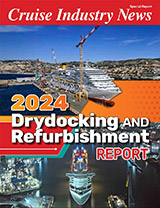With the first six months of 1995 on the books, the industry has reported a mixed performance with Carnival Cruise Lines and Royal Caribbean Cruise Line reporting net earnings while American Classic Voyages, Celebrity Cruises, and Kloster Cruise reported losses. In addition, Princess Cruises and Costa Crociere were profitable, although it is harder to compare their numbers inasmuch as they are “hidden” in company-wide reports or reported by different accounting standards.
Perspective
Regardless of all the negativism that surrounds the industry these days, four out of seven publicly held cruise lines made money in the first six months of 1995. The same four lines represent nearly 60 percent of industry capacity.
The three lines that reported losses represent about 16 percent of industry capacity. The financial status of the remaining operators, representing approximately 24 percent of capacity, is largely unknown although it is generally accepted that several of the smaller privately held companies have been operating in the red for some time.
Yet, it is clear that the profits posted so far in 1995 have come at increased marketing expense, deep cost cutting, and as a result of winning an intense battle for passengers.
The outlook promises more of the same based on all the new ships coming into service through 1998.
Hence, investors seem to be cooling somewhat to the industry and an independent investment evaluation firm such as Value Line ranks CCL and RCCL relatively low on its scale for safety and timeliness.
Deloitte & Touche published what it called a “Worldwide Cruise Line Valuation Analysis” recently, concluding that six publicly held cruise lines returned a compound annual growth of less than 1.2 percent between February 1990 and June 1995 compared to a compound annual growth rate of 10.3 percent for the S&P 500 for the same period.
According to Deloitte & Touche, if a hypothetical investor had put $100 in its Monthly Cruise Line Composite Index in February 1990, it would be $106 as of June of this year. However, the Composite peaked at $159 in January 1994 and has suffered a rapid decline since, hitting a low of $102 in March, 1995. The same $100 invested in the S&P 500 would have grown to $165.
Bright Spots
The bright spots were Carnival and RCCL.
CCL went public in 1987 at $15.50 per share; it split two-for-one in 1994; and now trades for $21 7/8.
A hypothetical investor who paid $15.50 for one share in 1987, now owns two shares valued at approximately $22.00 for a total of $44.00. That is a 184 percent return on the investment over nine years or an average annual return of more than 20 percent.
RCCL went public in 1993 at $18.00 and reached nearly $30 in 1994; its shares now trade for $22 1/4.
A hypothetical investor who paid $18.00 in 1993 would have seen his investment grow to $22.25 at press time, for a total increase of $4.25 or a 23 percent return over two-and-a-half years, or an average annual return of more than nine percent. In addition, both stocks pay dividends.
Furthermore, investors who play the market would have made a great deal more money by buying when the shares were low, CCL hit $8.12 in the fall of 1987 and a high of nearly $50 in 1994, and selling when high.



